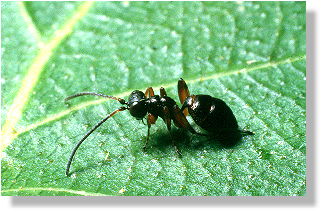 |
Her mother had penetrated
the wall of the cocoon with her ovipositor and placed an egg onto the
larva of the braconid. From it, a larva hatched and ate up the
braconid chrysalis as the braconid had done to the ladybird. With
the nutrients taken up and stored the ichneumonid could grow, turn into
a chrysalis and develop into an adult insect.
There is no way for the ichneumonid to bring good luck to our dotted object of sympathy anymore. Still, that fact that obvious baddies such as ladybird braconids have their own enemies is a little soothing - isn't it? |